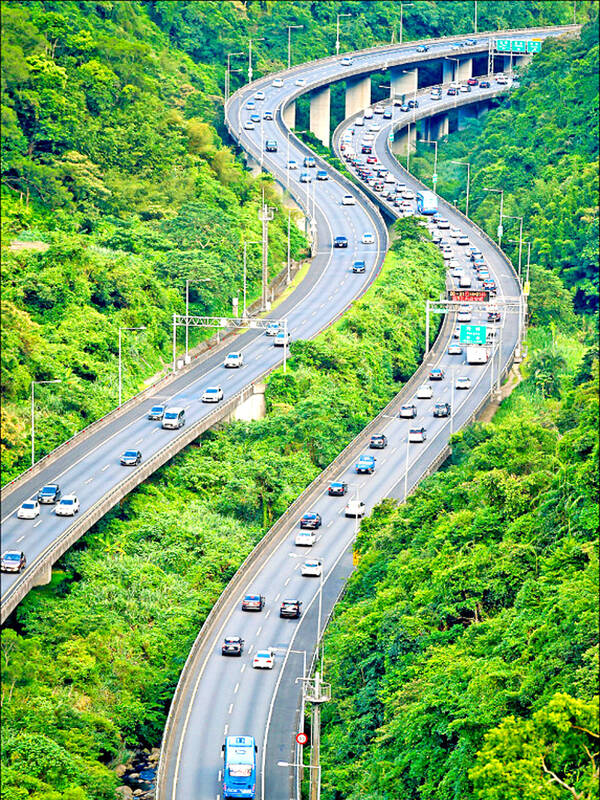Taiwan’s freeways are today expected to see the heaviest southbound traffic during the seven-day Lunar New Year holiday as people go on holiday outings or visit their spouse’s family, the Freeway Bureau said yesterday.
Today, the second day of the Year of the Dragon, is the fourth day of the Lunar New Year holiday, when many married daughters return to their parents’ homes in line with the hui niang jia (回娘家) tradition.
The traffic volume is forecast to reach 70 million vehicle-kilometers, a measure of traffic flow, bureau official Cheng Chieh-wen (鄭傑文) said yesterday, adding that the figure is 1.5 times more than the average.

Photo: Taipei Times file
Freeways on the west coast and the Chiang Wei-shui Memorial Freeway (Freeway No. 5) are expected to see a surge in traffic as early as 6am today, he said.
The Chiang Wei-shui Memorial Freeway would be heavily congested past 4pm, with 18 likely bottlenecks, while freeways on the west coast are expected to be congested well into the afternoon, he said.
Heavy congestion was yesterday reported in several areas along the nation’s freeways, with accidents making the situation worse.
As of 11am, the traffic volume had reached 38.2 million vehicle-kilometers and was expected to hit 122 million vehicle-kilometers by the end of the day, the bureau said.
Both figures were in line with estimates, it added.
The average traffic flow on freeways from midnight on Friday to 5am yesterday was 2.4 times more than the regular figure, said the bureau, which opened the emergency lanes along 33 sections of freeways prone to traffic congestion.
Although drivers had been advised to wait until after noon yesterday to travel south on freeways in western Taiwan and until after 5pm to use the southbound lanes of the Chiang Wei-shui Memorial Freeway to avoid potential traffic jams, traffic was still heavy as of 2:30pm on the southbound lanes of Freeway No. 5, with vehicles traveling 20kph to 40kph in the tunnel leading to Pinglin District (坪林) and 40kph to 60kph in the Hsuehshan Tunnel (雪山隧道), the bureau said.
Traffic was also backed up on the southbound lanes of the Formosa Freeway (Freeway No. 3) from Yingge District (鶯歌) and Guansi Township (關西), and on the Sun Yat-sen Freeway (Freeway No. 1) from Yangmei District (楊梅) to Hsinchu.
Three traffic accidents that occurred between 10am and 11am aggravated traffic congestion, although they were cleared by 11am, the bureau said.
It encouraged people driving around Taiwan to use the 1968 freeway app to monitor traffic conditions on freeways.
The 168.thb.gov.tw site also provides real-time information about traffic on provincial highways.
Meanwhile, the Central Weather Administration (CWA) said that most of Taiwan would experience sunny or cloudy weather over the Lunar New Year weekend after the past few days of rain.
The improved weather would prevail in most parts of the nation due to a continued decline in atmospheric moisture, but eastern Taiwan, the Hengchun Peninsula and mountainous areas in the west might still experience sporadic precipitation, it said.
The weather would likely remain unchanged until Thursday when atmospheric moisture conditions could change, the CWA said.
Even with the improvement in weather, temperatures are expected to remain low, because of the lingering effects of a continental cold air mass and radiative cooling, it said.
Low temperatures would continue across the country until Tuesday, the CWA said.

NATIONAL SECURITY: The Chinese influencer shared multiple videos on social media in which she claimed Taiwan is a part of China and supported its annexation Freedom of speech does not allow comments by Chinese residents in Taiwan that compromise national security or social stability, the nation’s top officials said yesterday, after the National Immigration Agency (NIA) revoked the residency permit of a Chinese influencer who published videos advocating China annexing Taiwan by force. Taiwan welcomes all foreigners to settle here and make families so long as they “love the land and people of Taiwan,” Premier Cho Jung-tai (卓榮泰) told lawmakers during a plenary session at the Legislative Yuan in Taipei. The public power of the government must be asserted when necessary and the Ministry of

CROSSED A LINE: While entertainers working in China have made pro-China statements before, this time it seriously affected the nation’s security and interests, a source said The Mainland Affairs Council (MAC) late on Saturday night condemned the comments of Taiwanese entertainers who reposted Chinese statements denigrating Taiwan’s sovereignty. The nation’s cross-strait affairs authority issued the statement after several Taiwanese entertainers, including Patty Hou (侯佩岑), Ouyang Nana (歐陽娜娜) and Michelle Chen (陳妍希), on Friday and Saturday shared on their respective Sina Weibo (微博) accounts a post by state broadcaster China Central Television. The post showed an image of a map of Taiwan along with the five stars of the Chinese flag, and the message: “Taiwan is never a country. It never was and never will be.” The post followed remarks

Proposed amendments would forbid the use of all personal electronic devices during school hours in high schools and below, starting from the next school year in August, the Ministry of Education said on Monday. The Regulations on the Use of Mobile Devices at Educational Facilities up to High Schools (高級中等以下學校校園行動載具使用原則) state that mobile devices — defined as mobile phones, laptops, tablets, smartwatches or other wearables — should be turned off at school. The changes would stipulate that use of such devices during class is forbidden, and the devices should be handed to a teacher or the school for safekeeping. The amendments also say

CONSISTENT COMMITMENT: The American Institute in Taiwan director said that the US would expand investment and trade relationships to make both nations more prosperous The US would not abandon its commitment to Taiwan, and would make Taiwan safer, stronger and more prosperous, American Institute in Taiwan Director Raymond Greene said. “The US’ commitment to Taiwan has been consistent over many administrations and over many years, and we will not abandon our commitment to Taiwan, including our opposition to any attempt to use force or coercion to change Taiwan’s status,” he said in an exclusive interview with the Liberty Times (the sister newspaper of the Taipei Times) on Friday last week, which was published in the Chinese-language newspaper yesterday. The US would double down on its efforts